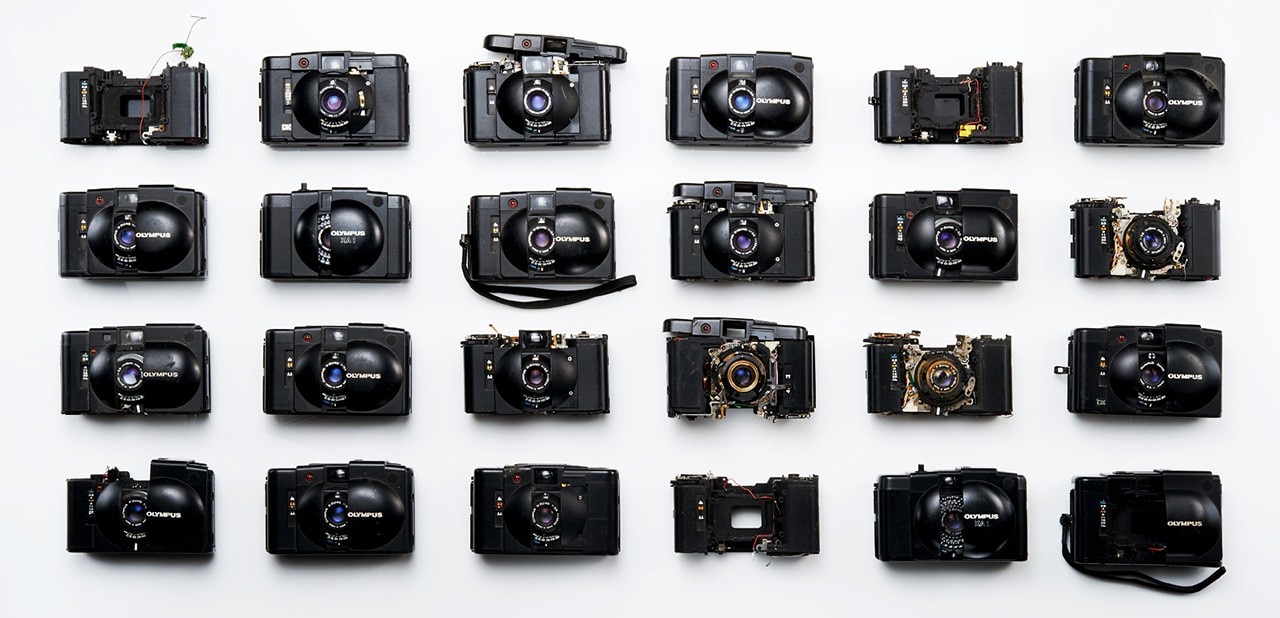Always borderline between practised and theorised photography, I converted to digital three times. But if there’s just one camera I’d like to be buried with, then it’s the XA, the Olympus branded analog so–called “egg”.
We’re talking about a fixed lens camera with optical viewfinder, manual focus, light meter and semi automatic shutter system. So far, nothing extraordinary. Except that everything is squeezed in a really, really compact size, so to be fit practically in every pocket, and that the viewfinder is Galilean — therefore very bright — and flaunts parallax–compensation marks and a 0.6X magnification, and that the focusing is coupled to a rangefinder with a base so short (1/2 inch!) but so accurate you won’t believe it, and that the shutter system is aperture–preferred — one of the two ways you can manually control the exposure —, and that the metering data are clearly shown in the little but bright viewfinder mentioned above, and that the lack of an internal mirror which goes with all rangefinder cameras, combined with a very (maybe too much) sensitive electromagnetic shutter release and a really light but sturdy plastic body, make the XA a quiet camera that can be used with very, very long exposure times (once you’ve set the aperture, it choses the related shutter speed, from 1/500 to 10 seconds, in order to achieve the right exposure).
A series of small tricks make the XA even more complete, without losing manegeability: the film–advancing is driven by a maybe not so scenic but very practical wheel, the aperture is set by sliding a small knob on the side of the lens, the ASA selector is located under the lens — just as the tiny and fluid focusing lever — and allows the camera to use film speeds from 25 (!) to 800 (maybe the only real downside, along with a not so fast shutter speed), not to mention a thin handle located at the base of the camera which, set at different opening angles, operates a +1.5 EV compensation (very useful in backlight conditions) first, then an audio battery check, and finally (at a 45 degrees opening angle, serving also as a clever tool to stabilze the framing in case of sloping surfaces) a self–timer with 12 sec. LED light and audio beep signalled delay. All gimmicks that allow one to use the camera without ever moving the eye from the viewfinder.
03.jpg.foto.rmedium.jpg)
But the real magic is hidden in the lens, a bright Zuiko 35 mm — that is to say an all–purpose lens, from almost lanscape, just moving one step back, to quasi portrait, just moving one step ahead — that sports an aperture range of f/2.8 to f/22 and a minimum focusing distance of 0.85m, pretty unique features for a camera so small. And how has it been possible to pack an optical system that complex in so little space?
That’s where comes in the genius of Maitani Yoshihisa, the master–designer–engineer responsible for all the other inventions — from the half–format PEN to the OM line, from XA’s little sisters (2, 3, 4 and 5, even more user–friendly but also less powerful) and the Mju (the super successful, and in this very moment super wanted, electronic heir to the XA) — which have made Olympus one of the most innovative and unpredictable companies in the market.
I still remeber my father, to whom I owe my passion for photography, praising Maitani san while showing me the optical scheme of the XA on an old issue of Fotografia Reflex magazine: a reversed (i.e. installed backwards) retrofocus wide–angle lens that features 6 elements in 5 groups of which — to fix the size issue and avoid the need of a protrunding lens (that, as in half of the competitors, would have weighed on the thickness) or a collapsible one (that, as the other half of the competitors, whould have involved further mechanisms and the related criticalities) — only the third is put into operation while focusing, thus resulting in an overall fixed depth of just 31 mm from the top of the lens to the film plane.
Icing on the cake, specifically designed flash units that attach to a side of the camera and that in the A11 option (contrary to the bigger but more efficient A16) keeps it still fully portable.
To make the XA even more surprising and unique in its own right, however, is that this concoction of techno wizardry is enclosed by one of the most distictive and groundbreaking feature of the time (1978): that sliding capsule design which, besides shielding the lens and, by switching off the camera, avoiding unwanted shots, makes the transition from dormant to operative (that is quite always from the pocket to the eye), fast and safe, and which has earned it the nickname of “egg” by which it is commonly known. Simple and brilliant, then, the little Olympus: just line an egg.
Raffaele Vertaldi is Domus visual consultant.
Photo © Austin Calhoon and Lordcolus via Wikimedia Commons, Licenza Creative Commons




01.jpg.foto.rmedium.png)
04.jpg.foto.rmedium.png)
05.jpg.foto.rmedium.png)
02.jpg.foto.rmedium.png)